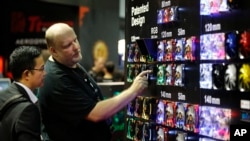Smart watches, bands and glasses still struggle to compete with smartphones as must-have mobile gadgets. But Asia's largest IT show this week shows an evolutionary maturing of wearable device technology following the release of Apple’s watch and the suspension of the Google Glass.
Nearly 50 exhibitors at the annual Computex Taipei this week are showing wearable devices, and their technology reveals advances after two years of industry-wide effort. One of the bands being shown counters the Apple Watch by offering a blank display for each user to design according to personal needs. A Taiwanese firm, ChipSIP Technology, modeled a $500 pair of smart glasses at the event and a local textile association displayed cycling vests that automatically light up in the dark. Their peers touted devices to track hunting dogs and missing children.
John Wang, the founder of Noodoe, the Taiwanese company behind the blank smart watch set for release later this year, spoke at a pre-show event. He urged consumers to break new ground.
“We ask the question, does every wearable, every smart watch, need to have so many features? What if we have a blank watch that has no features, not just a few features, but zero features? Then you get to infuse your ideas into it and it becomes something that only you have,” said Wang.
The launch of Apple’s first smart watches in April and suspension of the Google Glass, a forerunner to the global wearable device trend, motivated much of the technology shown at Computex Taipei this week. A show organizer said developers in Taiwan, a world high-tech hardware hub, are making new efforts at smart glasses to take Google’s place. Some are wary of making everyday watches as Apple is expected to take at least half the world market share.
Market research firm IDC said just 45.7 million wearables will ship this year across brands, but by 2019 the market is expected to grow to 126 million units.
Wearable devices released to date have earned only niche followings because they lack applications, power-saving batteries and fashionable looks. Most are only for athletes or the medical profession and require phones or tablets as base stations. Many devices cost more than low-end smartphones with the same functions and more. One analyst said the best wearable tools are skipping the Taipei show in favor of future events with a stronger mobile focus.
Developers indicated this week they had solutions. ChipSIP said its glasses require no smartphone, tablet or even hand motions. Smart wearable devices shown this year also come with stronger smartphone connectivity, ideal for joining automated networks of smart devices called the Internet of things. That term refers to objects such as doors and light bulbs that communicate with one another through chips and sensors. About 700 Computex vendors showed Internet of things set-ups such as automated homes and offices.
Ian Drew, chief marketing officer of British microchip designer ARM, said in an interview at the show that wearables as well as the Internet of things will need low-powered, standardized processors.
“Most of this wearable market will be radio driven with a battery, so you need an architecture that can go down to very low power. You need an architecture that has some standardization to it because you are going to want to write different applications using different environments. You may put the same piece of hardware into a refrigerator, into a toy, into a medical device into a wearable,” said Drew.
One of ARM’s processor designs works inside a wearable armband that detects muscle movement to figure out what users want to do. The device, called Myo, is aimed at bringing lifelike interaction to computer games.








